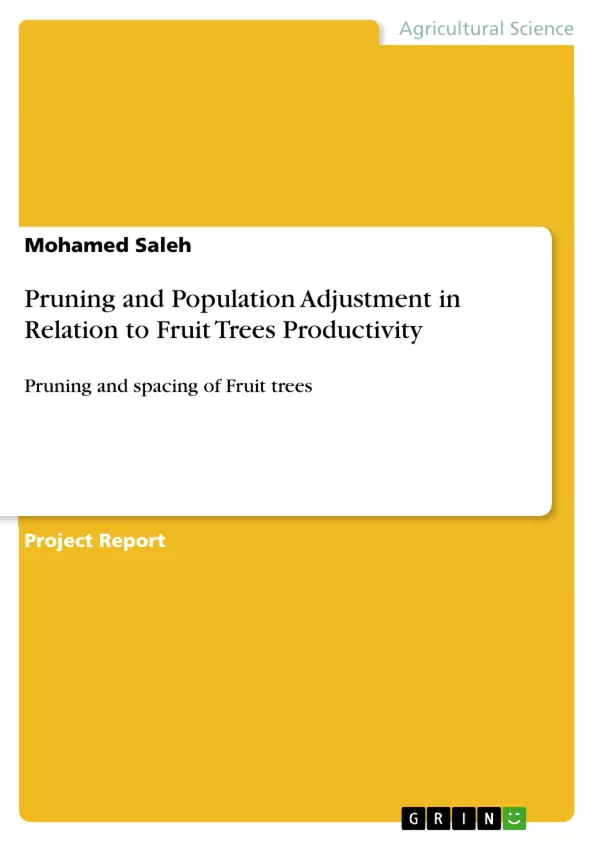High planting density is considered one of the modern management systems in new fruit orchards. Pruning and population adjustment are some of the main way to approach high productivity and good fruit quality under the modern management systems.
Pruning is defined as the management of plant structure and fruiting wood and it is considered one of the main factors affecting fruit trees production. There are many objectives for pruning i.e. controlling the direction of growth, developing a strong framework, controlling the amount of growth, improved productiveness, improving quality product, utilizing space efficiently and increasing the usefulness of plant. There are three main systems of fruit trees training (i) Central leader system, (ii) Modified leader system, (iii) Open center or vase system. Also there are several kinds of pruning i.e. heading back and thinning out, fine and coarse pruning and root pruning. However, it is important to select the suitable training system and kind of pruning according to the target of the pruning to reach optimum vegetative growth and maximum yield with high fruit quality.
On the other hand, population adjustment (plant distribution or planting density) is very important factor affecting fruit trees production. We can reach the optimum usefulness of the planted area by using best population adjustment of trees in the plantation. Trees can be planted using different systems:- triangle, rectangle, square system…..etc. On the other side, presence of pollinator trees through the orchard is very important for many fruit trees. Pollinator can be planted either in (1) Complete along rows, as one row of pollinator per two or four rows of the main cultivar. (2) The second tree in the second row. (3) The third tree in the third row. (4) Across rows through the orchard. On the other hand, good plant distribution is very helpful for mechanical serves in the plantation,
We can say that the key objective in planning a new orchard should be to maximize yield in the early years and still effectively produce larger yield of high quality fruits in the next years. This may be happened by utilizing space efficiently and increasing the usefulness of plant using the suitable training system, kind of pruning, also good population adjustment of the trees in the orchard beside the importance of the other factors affecting production process.
Inhaltsverzeichnis (Table of Contents)
- Pruning
- Principles of pruning
- Modification of apical dominance
- Balance of roots and top
- Altering growth phases
- Environmental factors
- Objectives of pruning
- Training
- Kinds of pruning
- Special pruning practices
- Chemical pruning
- Amount of pruning related to bearing habits
- Population adjustment
- REFERENCES
Zielsetzung und Themenschwerpunkte (Objectives and Key Themes)
This review article aims to examine the significant roles of pruning and population adjustment in enhancing fruit tree productivity, highlighting their impact on yield, fruit quality, and overall orchard management. It provides a comprehensive overview of the principles and practices associated with these techniques, emphasizing their importance in achieving optimal growth, maximizing yield, and promoting sustainable fruit production.
- Principles of Pruning
- Impact of Pruning on Fruit Tree Growth and Development
- Population Adjustment and Plant Distribution
- The Interplay between Pruning and Population Adjustment
- Maximizing Yield and Fruit Quality
Zusammenfassung der Kapitel (Chapter Summaries)
The review article focuses on the crucial roles of pruning and population adjustment in fruit tree productivity. It begins by exploring the principles of pruning, emphasizing key concepts such as apical dominance, root-top balance, growth phase manipulation, and the influence of environmental factors. The chapter on objectives of pruning discusses its various purposes, including controlling growth direction, developing a strong framework, regulating growth, enhancing productivity, improving fruit quality, optimizing space utilization, and maximizing the plant's overall usefulness.
The chapter on training delves into different fruit tree training systems, outlining their respective advantages and disadvantages. It also covers various types of pruning techniques, such as heading back, thinning out, fine and coarse pruning, and root pruning. The article emphasizes the importance of selecting the appropriate training system and pruning method based on the specific objectives and desired outcomes.
Population adjustment, which includes plant distribution and planting density, is explored as a vital factor influencing fruit tree productivity. The chapter discusses the benefits of strategic population adjustment, highlighting its role in maximizing orchard space utilization, ensuring optimal plant spacing, and facilitating efficient mechanical operations. The importance of pollinator trees within the orchard is also emphasized.
Schlüsselwörter (Keywords)
The core focus of this review article is the impact of pruning and population adjustment on fruit tree productivity. Key topics include the principles of pruning, objectives of pruning, training systems, types of pruning, population adjustment, plant distribution, planting density, pollinator trees, and the overall optimization of fruit tree yield and fruit quality.
- Quote paper
- Mohamed Saleh (Author), 2002, Pruning and Population Adjustment in Relation to Fruit Trees Productivity, Munich, GRIN Verlag, https://www.hausarbeiten.de/document/176054


